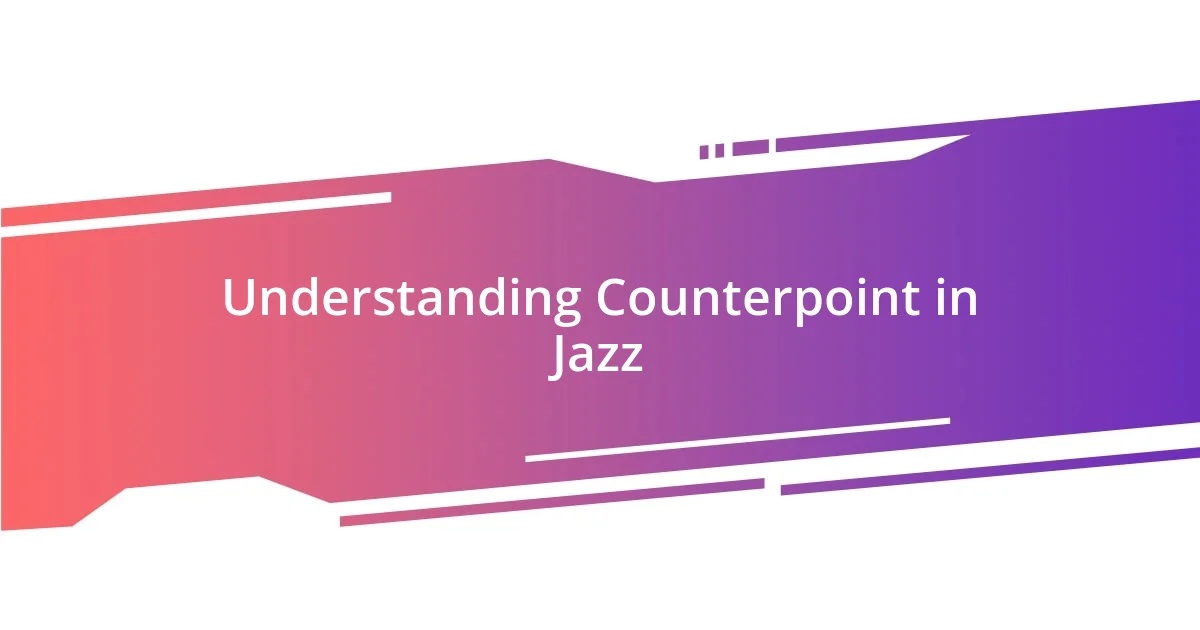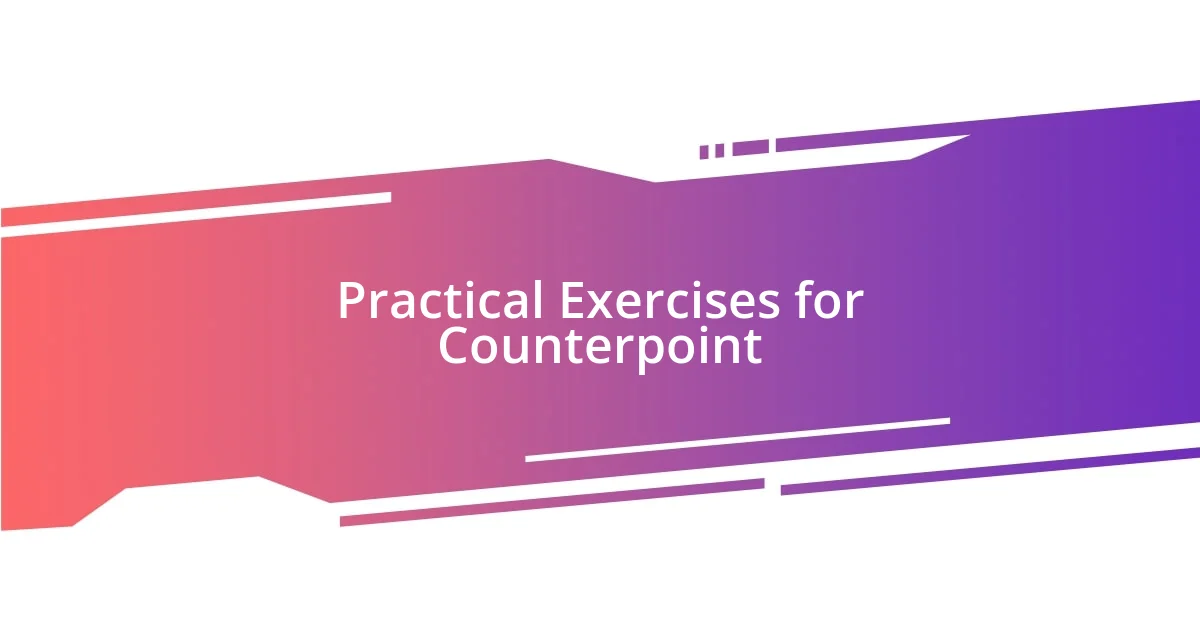Key takeaways:
- Counterpoint in jazz creates a dynamic interplay between melodic lines, allowing for individual expression while preserving cohesion within the music.
- Historical influences from classical music and key figures in early jazz and bebop have shaped the use of counterpoint, emphasizing musical dialogue and complex harmonies.
- Effective techniques for incorporating counterpoint include call-and-response, thematic development, and rhythmic variation, which enhance improvisation and creativity in performance.

Understanding Counterpoint in Jazz
When I first delved into counterpoint in jazz, I was fascinated by how it creates layers of sound, much like weaving a tapestry. It’s a rich interplay between voices, where melodic lines engage and often challenge one another. Have you ever listened to a jazz duo and felt how their lines dance around each other? That’s counterpoint at its finest.
Counterpoint allows musicians to express their individuality while still being part of a cohesive whole. I remember a gig where the saxophonist and the pianist traded phrases; it felt like a conversation where each participant listened intently and responded in kind. This push-and-pull establishes a tension that heightens emotional intensity and brings depth to the improvisation.
One aspect that continually intrigues me is how counterpoint can highlight the unique characteristics of each instrument. For example, the buoyant plucking of a bass guitar can beautifully contrast the smooth, continuous lines of a horn. Isn’t it remarkable how these different textures contribute to a richer listening experience? It’s this complex dance of interactions that makes counterpoint in jazz a truly exhilarating concept to understand and appreciate.

Historical Context of Jazz Counterpoint
The use of counterpoint in jazz has deep historical roots, tracing back to classical music traditions. As I explored this connection, I realized that early jazz musicians were often steeped in the rich harmonies of composers like Bach. It’s fascinating to think about how these classical frameworks influenced the way jazz artists crafted their melodies and interactions.
During the early 20th century, the emergence of New Orleans jazz showcased counterpoint in a unique way. Musicians like Louis Armstrong and Jelly Roll Morton were not just playing notes; they were engaging in a musical dialogue. I can still remember the first time I heard Morton’s piano playing, where he would seamlessly weave in and out of melodies, creating something that felt alive and spontaneous. That reminded me of how conversations can take on a life of their own, full of playful exchanges and unexpected turns.
Moreover, the rise of bebop in the 1940s brought counterpoint to the forefront. Innovators like Charlie Parker and Dizzy Gillespie began to experiment with complex harmonies and intricate lines. I often think about how their pioneering spirit shaped contemporary jazz, pushing the envelope on creativity. Their improvisations felt like conversations that explored both the familiar and the avant-garde, inspiring generations of musicians to do the same.
| Jazz Era | Key Figures |
|---|---|
| Early 20th Century | Louis Armstrong, Jelly Roll Morton |
| 1940s Bebop | Charlie Parker, Dizzy Gillespie |

Essential Techniques for Jazz Counterpoint
Incorporating counterpoint into jazz requires a blend of creativity, listening, and intentionality. One technique I often use involves the call-and-response style. This gives each musician a chance to echo or contrast the other’s phrases. I particularly recall a jam session where the trumpet and trombone engaged in a playful exchange. Their musical conversation felt organic, making me realize how vital it is to truly listen to your ensemble.
Here are some essential techniques to consider:
- Call and Response: A foundational element in jazz where musicians respond to each other’s phrases.
- Voice Leading: Ensuring smooth transitions between notes, allowing melodies to flow seamlessly.
- Contrapuntal Lines: Crafting independent melodies that complement each other’s movements.
- Harmonic Awareness: Understanding chord structures to harmonize effectively with the counterpoint.
- Rhythmic Variation: Playing with different rhythms adds layers and keeps the listener engaged.
Another vital technique that I enjoy employing is the exploration of thematic development. I often challenge myself to take a single melodic idea and transform it throughout a piece. One particular performance stands out; I took a simple phrase and altered its rhythm and harmony in several iterations. The audience could feel the evolution, as if they were part of a shared journey. It’s these moments of thematic exploration that make counterpoint an exhilarating experience both for the musician and the listener.

Practical Exercises for Counterpoint
When it comes to practical exercises for counterpoint, one of my favorite approaches is to start by experimenting with simple two-part harmonies. I like to choose a basic melody and then create a counter-melody that plays off it. There’s something exhilarating about hearing those lines interact, almost like they’re conversing with each other. Have you ever tried playing a simple melody while singing a contrasting line? The challenge of ensuring both parts remain distinct yet harmonious ignites a sense of creativity that I find incredibly rewarding.
Another exercise I often recommend is improvising a duet with a fellow musician. Finding a partner to jam with can open a treasure trove of ideas. We would often set a rhythm and take turns presenting melodies, all while crafting a counterpoint that flips the narrative. I remember a night where I was on stage with a bassist, and his riffs inspired me to respond with unexpected flourishes. That spontaneous interplay exercised my listening skills, reinforcing the importance of being attentive and adaptable in a live musical conversation.
Lastly, I suggest transcribing and analyzing counterpoint from classic jazz pieces. Sitting at the piano, I often take a track that I admire, dissecting the interplay between instruments. During one memorable session, I worked on Charlie Parker’s lines, feeling a rush of inspiration as I deciphered his intricate weaving of melodies. It was like peeking behind the curtain of his genius. This not only enhanced my understanding but also allowed me to incorporate those elements into my own playing. Have you ever explored the scores of your favorite jazz artists? It can really deepen your appreciation for the subtle dance of counterpoint in jazz.

Analyzing Jazz Standards with Counterpoint
Analyzing jazz standards through the lens of counterpoint is a fascinating journey. I often dive into classics like “Autumn Leaves” or “Blue Bossa,” where the melodies show an intricate dance of voices. It’s remarkable how listening for contrasting lines reveals the richness of the piece; have you experienced that moment where a simple chord progression suddenly blossoms into a vibrant conversation?
In a recent rehearsal, I chose to focus on the counterpoint in “Take the ‘A’ Train.” As I played, I began to notice how Duke Ellington’s arrangement allows for simultaneous voices to complement each other. I felt an electric excitement when layering my own improvisations on top, discovering how a well-placed note can shift the whole dynamic. It reminded me that analyzing these standards isn’t just academic; it’s about feeling the music and letting it inform our own expressions.
I encourage fellow musicians to get lost in these standards with me. As you analyze different interpretations, you’ll uncover how each artist uniquely addresses counterpoint. I once spent hours listening to snatches of various versions of “All the Things You Are,” captivated by the subtle variations in counterpoint that each artist brought. It made me realize: every standard is a canvas, and our interpretations add strokes, turning it into a personal masterpiece. What does your analysis uncover about your own style?

Incorporating Counterpoint in Improvisation
Incorporating counterpoint in improvisation has always felt like an exhilarating challenge for me. One approach I embrace is intentionally shifting between melodies during a solo. For instance, I like to play a phrase, then deliberately echo it in a different register while adding a contrasting rhythm. Can you visualize that? The thrill of weaving different lines together creates a texture that not only captivates the audience but also deepens my connection with the music.
A memorable experience I had was during a jam session where I decided to play off a saxophonist’s melody by introducing a counterpoint that swung in a different direction harmonically. As we traded solos, I could feel the musical dialogue evolving, almost like a dance where each step led to unexpected surprises. It was in those moments that I realized how counterpoint can transform improvisation into a compelling conversation, emphasizing the importance of listening and responding in real-time.
Often, I find that improvising with a clearly defined structure allows me to explore counterpoint more effectively. For example, setting a harmonic foundation and then layering my improvisation with counter-melodies has proven to be a powerful method. During one practice session, I was fascinated by how a simple bass line could inspire intricate, flowing lines above it. Have you ever had a similar moment where the foundational elements guided your creativity in unexpected ways? That’s where the magic lies—nurturing those moments of creativity that arise through counterpoint in improvisation.

Tips for Creating Original Counterpoint
Creating original counterpoint can truly expand your musical expression. One of my go-to strategies involves experimenting with intervallic leaps in my melodies. For instance, last week, I played around with a major seventh interval, which added a brilliant tension to my lines. I could feel the excitement coursing through me as I discovered how this unexpected jump opened up new pathways in my improvisation. Have you ever tried moving away from stepwise motion? It can lead you to thrilling new musical adventures.
Another tip I’ve found effective is to juxtapose rhythmic motifs. During a recent practice session, I contrasted an upbeat melody with a slow, syncopated counter-melody. The blend created a rich, textured sound that kept me completely engaged. I remember feeling as though I was part of a conversation where both voices had equal weight. Isn’t it amazing how simple rhythmic shifts can transform the entire feel of a piece? It’s a reminder that counterpoint doesn’t just reside in melody but pulses through rhythm as well.
Lastly, I always make it a point to listen closely to the dynamics of each line I’m creating. When I deliberately vary the volume and articulation, I can turn even a basic phrase into something dynamic and compelling. I recall a particularly rewarding moment when varying my dynamics during a performance allowed the counterpoint to breathe and come to life. Have you noticed how a Change in dynamics can elevate your musical story? It’s incredible how small adjustments can significantly impact how your audience perceives the counterpoint in your music.















